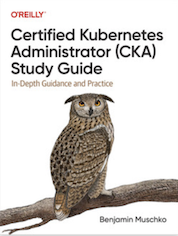Tag Cloud
Currently Reading
Latest Book Reviews
- Certified Kubernetes Application Developer (CKAD) Study Guide, 2nd Edition Posted on January 11, 2025
- Rancher Deep Dive Posted on March 31, 2023
- Leveraging Kustomize for Kubernetes Manifests Posted on March 24, 2023
- Automating Workflows with GitHub Actions Posted on October 13, 2022
- Deep-Dive Terraform on Azure Posted on August 30, 2022 All Book Reviews
Latest Posts
- OpenBSD: PF firewall for the paranoid Posted on January 13, 2013
- Writing custom Nagios plugins: check_public-ip Posted on January 2, 2013
- Installing Nagios Remote Plugin Executor in FreeBSD 9.1 Posted on January 2, 2013
- Cron monitoring plugin for Nagios Posted on January 2, 2013
- Installing Nagios Remote Plugin Executor in Solaris 11 Posted on December 30, 2012
January 13, 2013
OpenBSD: PF firewall for the paranoid
by Alpha01
Block all traffic except for ssh.
/etc/pf.conf
tcp_services = "{ 22 }"
block all
pass out on em0 proto tcp to any port $tcp_services keep state
pass in on em0 proto tcp to any port $tcp_services keep state
Enabling rules:
pfctl -e ; pfctl -f /etc/pf.conf
pfctl: pf already enabled
pf January 2, 2013
Writing custom Nagios plugins: check_public-ip
by Alpha01
Now that I think Nagios is the greatest thing since slice bread, I’m slowly but surely re-writing all my custom monitoring scripts to Nagios plugins.
The following is a Nagios plugin ready script that I used to replace my old public IP monitoring (See https://www.rubysecurity.org/ip_monitoring).
#!/bin/bash
STATE_OK=0
STATE_WARNING=1
STATE_CRITICAL=2
STATE_UNKNOWN=3
current_ip="YOUR-IP-ADDRESS-HERE"
ip=`curl -connect-timeout 30 -s ifconfig.me`
if [ "$current_ip" != "$ip" ] || [ -z "$ip" ]
then
if [[ "$ip" =~ "Service Unavailable" ]] || [[ "$ip" =~ "html" ]]
then
echo "IP service monitoring is unavailable."
exit $STATE_WARNING
elif [[ "$ip" =~ [0-9]{1,3}\.[0-9]{1,3}\.[0-9]{1,3}\.[0-9]{1,3} ]]
then
echo "ALERT: Public IP has changed. NEW IP: $ip"
exit $STATE_CRITICAL
else
echo "Unknown state detected."
exit $STATE_UNKNOWN
fi
else
echo "Public OK: $ip"
exit $STATE_OK
fi
bash nagios January 2, 2013
Installing Nagios Remote Plugin Executor in FreeBSD 9.1
by Alpha01
This also installs the Nagios plugins in addition of nrpe. Follow the text-based menu install options. The installer will create and configure the nagios user account, and will install the naios and nrpe plugins in /usr/local/libexec/nagios.
cd /usr/ports/net-mgmt/nrpe2
make install clean
Update permissions.
chown -R nagios:nagios /usr/local/libexec/nagios
Create nrpe config file.
cd /usr/local/etc
cp nrpe.cfg-sample nrpe.cfg
Add the following entry to /etc/rc.conf.
nrpe2_enable="YES"
Edit nrpe.cfg (Example: 192.168.1.5 is my nagios server)
allowed_hosts=192.168.1.5
Start the nrpe daemon.
/usr/local/etc/rc.d/nrpe2 start
nagios freebsd January 2, 2013
Cron monitoring plugin for Nagios
by Alpha01
#!/bin/bash
STATE_OK=0
STATE_WARNING=1
STATE_CRITICAL=2
STATE_UNKNOWN=3
CRON_CHECK=`ps aux | grep cron|grep -v grep|awk '{print $NF}'|grep -E -e '^(/usr/sbin/cron|crond)$'|wc -l`
case "${CRON_CHECK}" in
0) echo "Crond is not running."; exit ${STATE_CRITICAL}
;;
1) echo "Crond is running."; exit ${STATE_OK}
;;
*) echo "More than one crond process detected / crond is in an unknown state."; exit ${STATE_WARNING}
;;
esac
bash nagios December 30, 2012
Installing Nagios Remote Plugin Executor in Solaris 11
by Alpha01
Install gcc
pkg install pkg://sfe/runtime/gcc pkg://sfe/sfe/developer/gcc
Install system headers (not really sure if all listed were necessary):
pkg install SUNWhea SUNWbinutils SUNWarc SUNWgcc SUNWgccruntime SUNWlibsigsegv SUNWgm4 SUNWgnu-automake-110 SUNWaconf
Update your PATH:
PATH=$PATH:/usr/gcc/bin:/usr/sfw/bin:/usr/ccs/bin
export PATH
Manually create nagios user account, home directory, group, and assigned him a password.
mkdir -p /usr/local/nagios
useradd -d /usr/local/nagios -m nagios
groupadd nagios
usermod -G nagios nagios
passwd nagios
Download, extract, compile and install nrpe.
wget http://prdownloads.sourceforge.net/sourceforge/nagios/nrpe-2.13.tar.gz
tar -xvf http://prdownloads.sourceforge.net/sourceforge/nagios/nrpe-2.13.tar.gz
cd /opt/nrpe-2.13
./configure --with-nagios-user=nagios --with-nagios-group=nagios
make install
make install-daemon-config
cp src/check_nrpe /usr/local/nagios/libexec
Update permissions.
chown -R nagios:nagios /usr/local/nagios/
Add the following entry to /etc/services
nrpe 5666/tcp # NRPE
Add the following entry to /etc/inetd.conf
nrpe stream tcp nowait nagios /usr/sbin/tcpd /usr/local/nagios/bin/nrpe -c /usr/local/nagios/etc/nrpe.cfg -i
Convert and add the new legacy inetd entry to SMF.
inetconv
inetconv -e
nagios solaris 